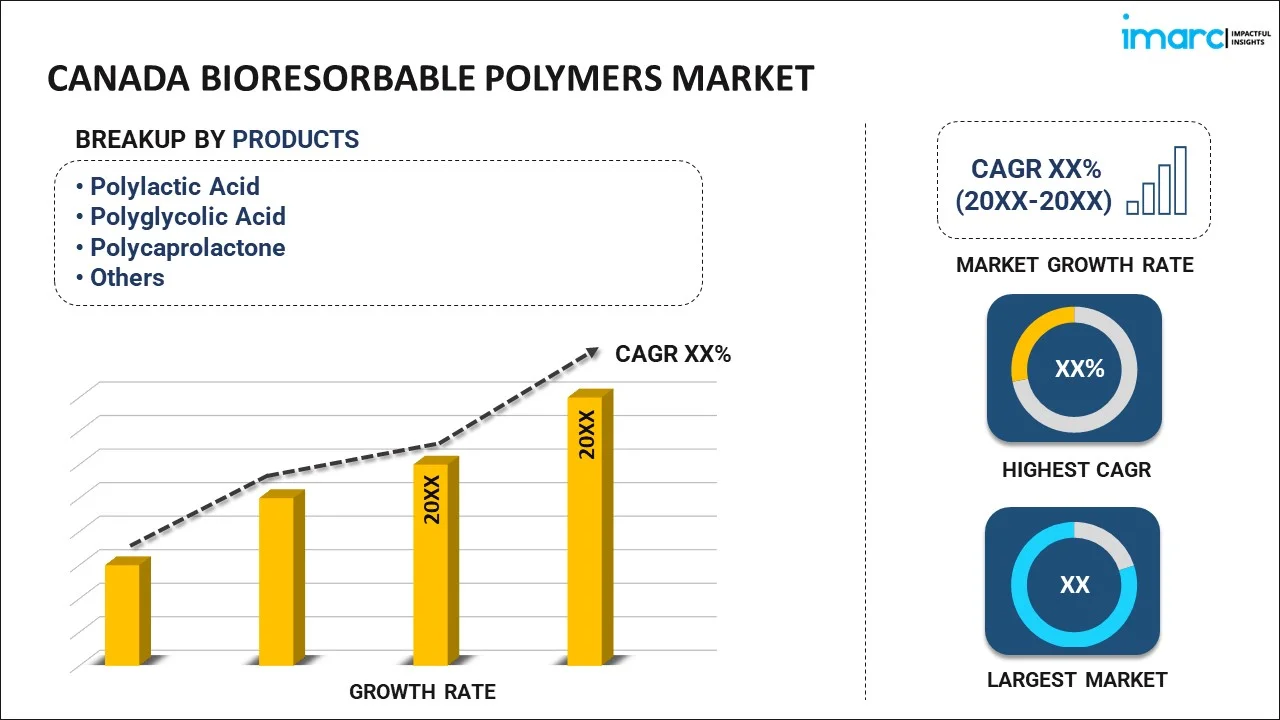
Canada Bioresorbable Polymers Market Report by Product (Polylactic Acid, Polyglycolic Acid, Polycaprolactone, Polysaccharides, Proteins, and Others), Application (Drug Delivery, Orthopaedic Fixation, Dental Implants, Tissue Staples, Sutures, and Others), End Use (Hospitals, Ambulatory Surgical Centers, and Others) 2025-2033
Market Overview:
The Canada bioresorbable polymers market size reached USD 178.0 Million in 2024. Looking forward, IMARC Group expects the market to reach USD 379.0 Million by 2033, exhibiting a growth rate (CAGR) of 8.80% during 2025-2033.
|
Report Attribute
|
Key Statistics
|
|---|---|
|
Base Year
|
2024
|
|
Forecast Years
|
2025-2033
|
|
Historical Years
|
2019-2024
|
|
Market Size in 2024
|
USD 178.0 Million |
|
Market Forecast in 2033
|
USD 379.0 Million |
| Market Growth Rate (2025-2033) | 8.80% |
A bioresorbable polymer refers to a class of materials that can be absorbed by the body and does not need any mechanical removal. Some of the commonly available bioresorbable polymers include polylactic acid, polyglycolide, polycaprolactone, polysaccharides, etc. They are usually manufactured from vegetable oils derived from rapeseed, sunflower corn fiber, food processing waste, potato, paper mill sludge, etc. Bioresorbable polymers offer various benefits, including lesser stiffness, precise material composition, enhanced microstructure control, etc. A range of physical and degradation properties enables these polymers to be utilized for numerous medical applications, such as tissue engineering, drug delivery, dental implants, orthopedic fixation, etc.
Canada Bioresorbable Polymers Market Trends:
The escalating usage of bioresorbable polymers in biomedical settings, including prostheses, sutures, orthopedic surgeries, implants, etc., based on their enhanced dissolubility and faster healing, is primarily driving the Canada bioresorbable polymers market. Bioresorbable polymer-based implants also aid in improving patient care and clinical outcomes while avoiding complex medical procedures. Besides this, the expanding geriatric population in Canada, which is leading to the increasing incidences of osteoporosis and osteoarthritis, is creating a positive outlook for the regional market. Furthermore, the rising adoption of bioresorbable polymers in wound management, as they provide an excellent barrier against bacterial penetration and enhance oxygen permeability, is acting as another growth-inducing factor. Additionally, bioresorbable polymers are also utilized as an efficient drug carrier that allows regulated and consistent delivery of a variety of medicinal components, such as antibiotics and anti-cancer medications. Moreover, the emerging popularity of bioresorbable polymer powders for dermal filler procedures is further propelling the product demand in the region. In addition to this, the extensive application of bioresorbable polymers in the field of tissue engineering to develop organ-like structures via 3D scaffold printing is expected to drive the Canada bioresorbable polymers market in the coming years.
Key Market Segmentation:
IMARC Group provides an analysis of the key trends in each segment of the Canada bioresorbable polymers market report, along with forecasts for the period 2025-2033. Our report has categorized the market based on product, application and end use.
Breakup by Product:

- Polylactic Acid
- Polyglycolic Acid
- Polycaprolactone
- Polysaccharides
- Proteins
- Others
Breakup by Application:
- Drug Delivery
- Orthopaedic Fixation
- Dental Implants
- Tissue Staples
- Sutures
- Others
Breakup by End Use:
- Hospitals
- Ambulatory Surgical Centers
- Others
Competitive Landscape:
The competitive landscape of the industry has also been examined with some of the key players being Ashland, Bezwada Biomedical LLC, Corbion, Evonik Industries, Foster Corporation, Polysciences, Inc., Putnam Plastics, and Zeus Industrial Products, Inc.
Report Coverage:
| Report Features | Details |
|---|---|
| Base Year of the Analysis | 2024 |
| Historical Period | 2019-2024 |
| Forecast Period | 2025-2033 |
| Units | Million USD |
| Segment Coverage | Product, Application, End Use |
| Companies Covered | Ashland, Bezwada Biomedical LLC, Corbion, Evonik Industries, Foster Corporation, Polysciences, Inc., Putnam Plastics, and Zeus Industrial Products, Inc. |
| Customization Scope | 10% Free Customization |
| Post-Sale Analyst Support | 10-12 Weeks |
| Delivery Format | PDF and Excel through Email (We can also provide the editable version of the report in PPT/Word format on special request) |
Key Questions Answered in This Report:
- How has the Canada bioresorbable polymers market performed so far and how will it perform in the coming years?
- What has been the impact of COVID-19 on the Canada bioresorbable polymers market?
- What is the breakup of the market based on the product?
- What is the breakup of the market based on the application?
- What is the breakup of the market based on the end use?
- What are the various stages in the value chain of the industry?
- What are the key driving factors and challenges in the market?
- What is the structure of the Canada bioresorbable polymers market and who are the key players?
- What is the degree of competition in the market?
Need more help?
- Speak to our experienced analysts for insights on the current market scenarios.
- Include additional segments and countries to customize the report as per your requirement.
- Gain an unparalleled competitive advantage in your domain by understanding how to utilize the report and positively impacting your operations and revenue.
- For further assistance, please connect with our analysts.
 Inquire Before Buying
Inquire Before Buying
 Speak to an Analyst
Speak to an Analyst
 Request Brochure
Request Brochure
 Request Customization
Request Customization




.webp)




.webp)












